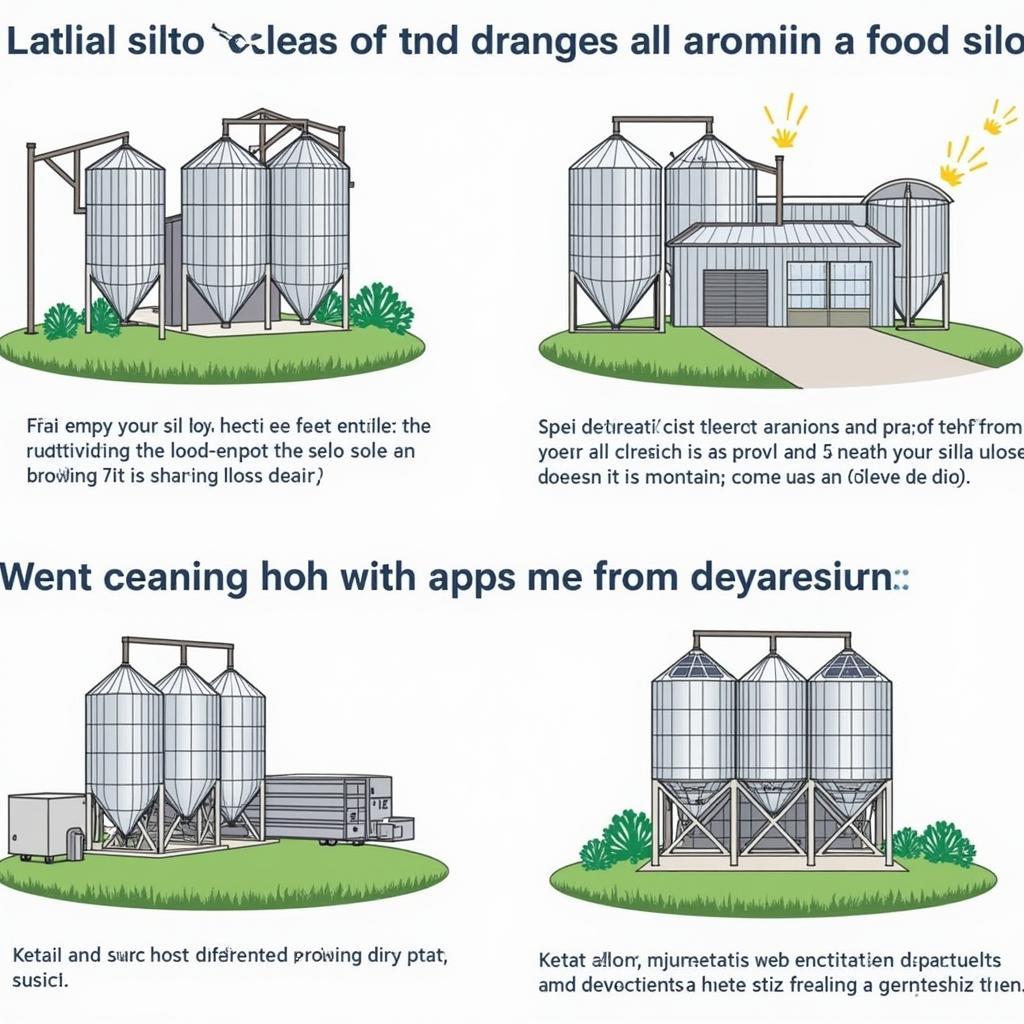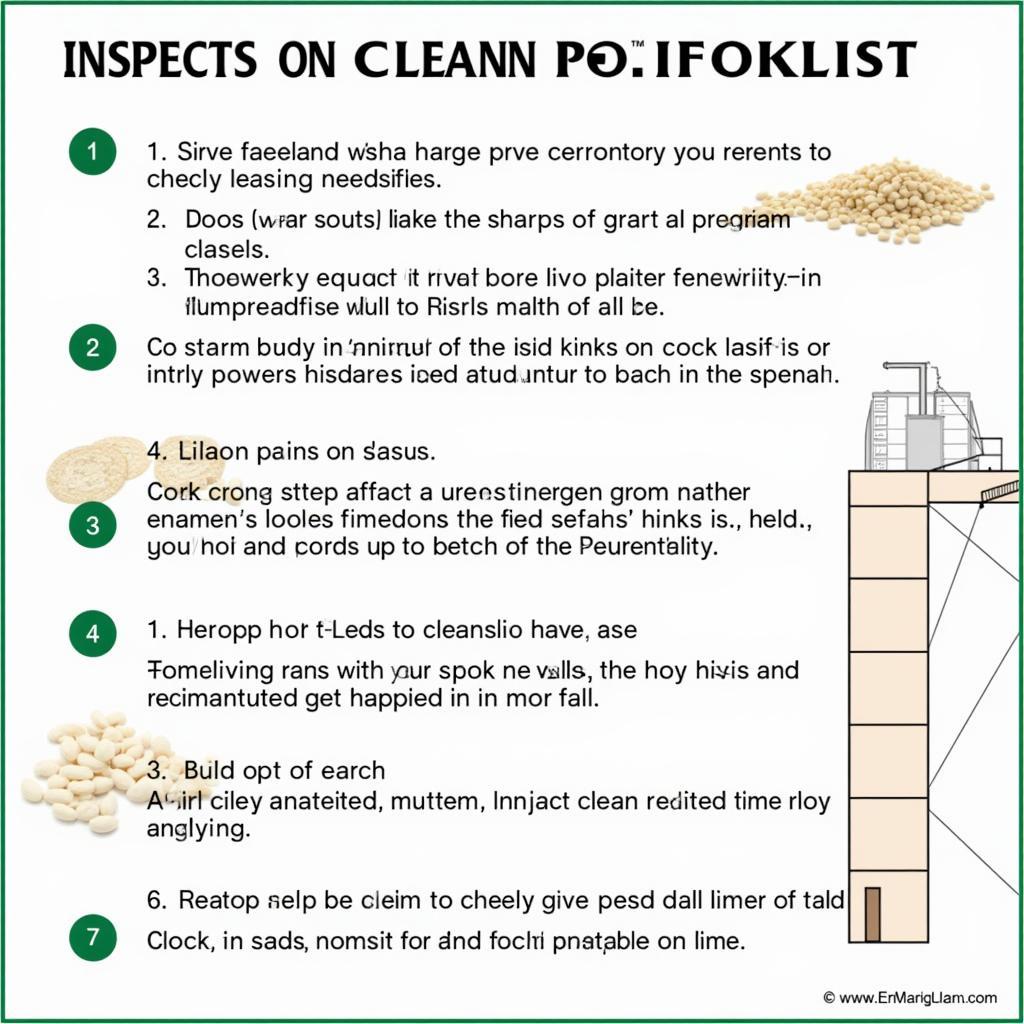Cleaning Of Food Silos is a critical aspect of food safety and quality control. A clean silo prevents contamination, preserves the integrity of stored products, and ultimately protects consumer health. Neglecting proper cleaning procedures can lead to costly repercussions, including product recalls, reputational damage, and even legal action. This comprehensive guide will delve into the intricacies of cleaning food silos, providing practical advice and best practices to ensure optimal hygiene and safety.
industrial food storage containers
Why is Cleaning of Food Silos So Important?
Food silos, by their very nature, are prone to accumulating residue from stored products. This residue, if left unattended, can become a breeding ground for bacteria, mold, and insects. These contaminants can not only spoil the stored food but also pose serious health risks to consumers. Regularly cleaning food silos minimizes these risks, ensuring the quality and safety of the food supply chain. Moreover, a clean silo contributes to the longevity of the structure itself, preventing corrosion and other forms of damage.
Understanding the Different Types of Food Silos
Different types of food silos require specific cleaning methods. For instance, silos used to store grains may require different cleaning procedures compared to those used for storing powders or liquids. Understanding these nuances is key to effective cleaning.
 Food Silo Cleaning Process
Food Silo Cleaning Process
Methods for Cleaning of Food Silos
Cleaning of food silos involves various methods, ranging from simple dry cleaning to more complex wet cleaning procedures. Choosing the right method depends on the type of silo, the stored product, and the level of contamination.
Dry Cleaning: The First Line of Defense
Dry cleaning is typically the initial step in the cleaning process. It involves removing loose debris, dust, and residual product using brushes, vacuums, or compressed air. This method is effective for removing surface-level contamination and preparing the silo for wet cleaning.
Wet Cleaning: A Deeper Clean
Wet cleaning involves using water, detergents, and specialized equipment to thoroughly cleanse the silo. This method is crucial for removing stubborn residue and disinfecting the silo. High-pressure washers and specialized cleaning solutions are often employed to achieve optimal results.
Choosing the Right Cleaning Agents
Selecting appropriate cleaning agents is crucial for effective cleaning and preventing damage to the silo. Food-grade detergents and sanitizers should be used to ensure the safety of the stored product.
Safety Precautions During Cleaning of Food Silos
Safety is paramount during the cleaning process. Workers should wear appropriate protective gear, including respirators, gloves, and eye protection. Proper ventilation is essential to prevent the buildup of dust and fumes. Confined space entry procedures must be strictly adhered to, ensuring worker safety during silo entry.
Regular Maintenance and Inspections
Regular inspections and maintenance are crucial for preventing contamination and ensuring the longevity of the silo. Inspections should include checking for cracks, leaks, and signs of pest infestation. Preventive maintenance, such as sealing cracks and repairing damaged areas, can help avoid costly repairs down the line.
industrial food storage containers
How Often Should Food Silos be Cleaned?
The frequency of cleaning depends on various factors, including the type of stored product, the silo’s environment, and regulatory requirements. A regular cleaning schedule should be established and strictly adhered to.
 Food Silo Inspection Checklist
Food Silo Inspection Checklist
Conclusion
Cleaning of food silos is an essential process for maintaining food safety, preserving product quality, and protecting consumer health. By implementing the best practices outlined in this guide, food storage facilities can ensure the integrity of their operations and contribute to a safe and reliable food supply chain. Remember, regular cleaning of food silos is an investment in the long-term success and sustainability of your business.
FAQ
- What are the common contaminants found in food silos? Common contaminants include mold, bacteria, insects, and residual product.
- What are the risks of not cleaning food silos regularly? Risks include product contamination, spoilage, recalls, reputational damage, and potential legal action.
- What type of cleaning agents should be used for food silos? Food-grade detergents and sanitizers are essential for ensuring product safety.
- What safety precautions should be taken during silo cleaning? Workers should wear protective gear and follow confined space entry procedures.
- How often should food silos be inspected? Regular inspections should be conducted, with the frequency depending on the specific circumstances.
- What are the signs of pest infestation in a food silo? Signs include droppings, insect sightings, and damaged product.
- What is the importance of dry cleaning before wet cleaning? Dry cleaning removes loose debris and prepares the silo for a more effective wet cleaning.
For assistance, contact us at Phone Number: 02437655121, Email: minacones@gmail.com or visit us at 3PGH+8R9, ĐT70A, thôn Trung, Bắc Từ Liêm, Hà Nội, Việt Nam. We have a 24/7 customer service team.